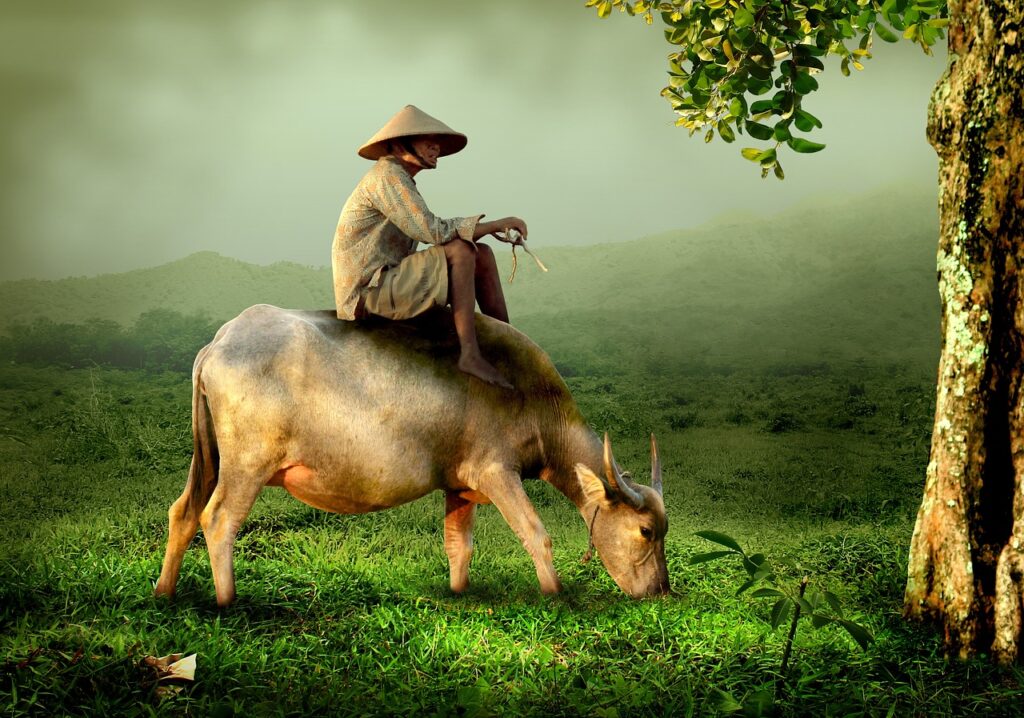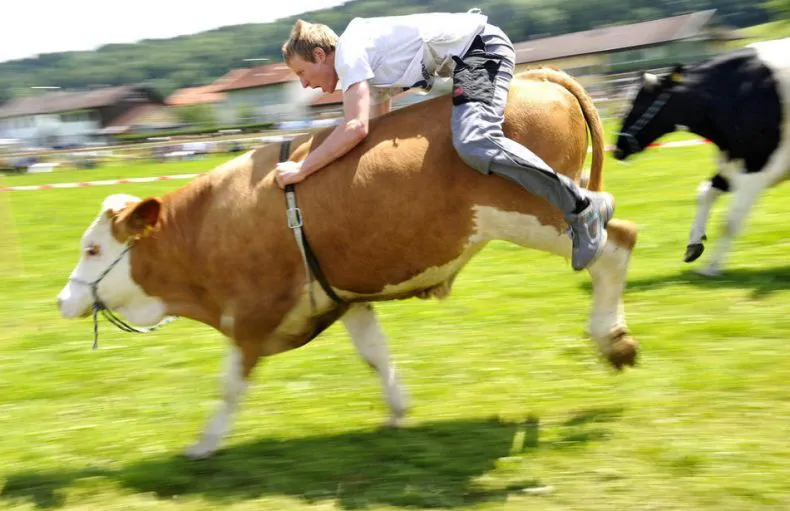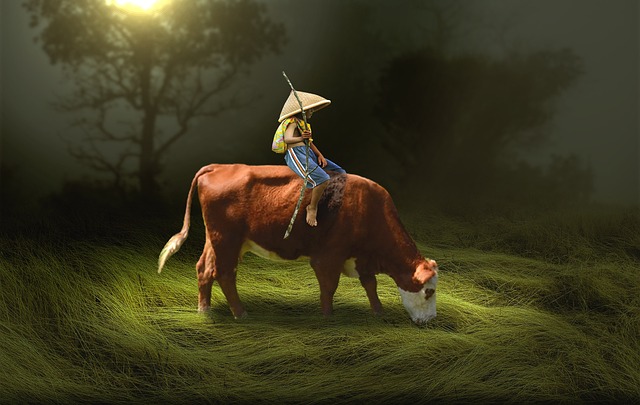When we imagine riding animals, our minds often conjure up images of horses cantering across open fields or through ancient pathways. But have you ever wondered about the possibility of riding cows, those gentle giants that graze in pastures?
Yes, it is theoretically possible to ride a cow, similar to other quadruped animals. However, it’s important to note that while such an endeavour is feasible, it’s not advisable. Cows are not naturally designed for riding, which means that if you intend to ride them, you would need to train them accordingly.
Here, you’ll have the opportunity to delve deeper into the topic and gather more information about it.
How a Cow Can Be Trained So You Can Ride It
Patience: Patience is indeed key when training any animal. The process of getting a cow accustomed to being ridden will take time and consistent effort.
Selecting the Right Cow: Opt for the gentlest cow in the herd, as temperament plays a significant role in how well the training process goes.
Starting with a Calf: Training a calf is a better approach due to its smaller size and generally more malleable temperament. Building trust through treats and spending time is a good foundation.
Desensitization: Gradual desensitization is important. Begin by moving your hands over the cow’s back to familiarize it with your touch. Then, apply gentle pressure to simulate weight.
Building Trust: Spend time consistently to build trust with the cow. Repeating the touch and pressure exercises over a week will help the cow associate you with safety.
Sitting on the Cow: Over time, progress to sitting briefly on the cow’s back and then dismounting. Repeating this step for weeks helps the cow get accustomed to the weight.
Enclosed Area: Transition to a smaller enclosed area with fewer distractions. This environment will aid in minimizing the cow’s potential stress during training.
Teaching Responses: Create reins and teach the cow to respond to them. Start with simple directional cues and see how the cow reacts. This is a crucial step for maintaining control during riding.
Progressive Rides: As the cow becomes more responsive to your cues, take short rides in less busy areas to minimize stress and potential danger.
Moderation: Given that cows are not anatomically designed for riding, it’s important to limit riding time to around 5 minutes a day to prevent harm or discomfort to the cow.
Pros of Riding Cows:

1. More Riding Room: When comparing the body of a cow to that of a horse, it’s evident that cows have a wider frame. This larger frame provides riders with a more stable surface and increased area to sit on during the ride. This can aid in maintaining balance and stability.
2. Hardy Animals: Cows are known for their durability. Their ability to withstand small scratches and navigate challenging terrains, such as rocky surfaces, makes them potentially well-suited for rides through rugged landscapes.
3. Calm Demeanor: Cows possess a generally calm and composed demeanour. They are less likely to be easily startled by unexpected environmental factors along the riding path, which could contribute to a safer and more predictable ride.
Cons of Riding Cows:
1. Quick Fatigue: Cows are not accustomed to carrying riders on a regular basis. Consequently, they may tire quickly from the unfamiliar activity of being ridden. Regular riding could lead to undue strain on the cow, potentially affecting its well-being.
2. Poor Water Handling: Cows are generally not inclined to cross bodies of water during rides. This limitation can pose a challenge when planning routes, as bodies of water could impede progress and even leave riders stranded.
3. Lengthy Training Process: Training a cow for riding is a time-consuming endeavour. The process of acclimating a cow to the concept of being ridden requires consistent and patient training over several months. The extensive training period is a significant investment of time and effort.
Are There Specific Breeds of Cows That Are More Suited for Riding?
While cows are not traditionally bred or suited for riding due to their anatomical and behavioural differences from horses, there are some breeds that might be considered more adaptable to the concept of being ridden.
Keep in mind that even among these breeds, it’s important to approach the idea of riding cows with caution and prioritize their well-being. Here are a few breeds that have been suggested as potentially more suitable for riding:
Texas Longhorn: Texas Longhorns are known for their gentle nature and impressive horns. Their larger size and sturdy build might make them more accommodating to riders compared to other breeds.
Highland Cattle: Highland cattle are recognized for their shaggy coats and calm temperament. Their robust nature could make them more tolerant of carrying some weight.
Brahman: Brahman cattle are known for their heat tolerance and resilience. Their strength and relatively calm disposition might make them candidates for riding in certain contexts.
Zebu: Zebu cattle, a type of Brahman breed, are smaller in size and have a gentle disposition. Their manageable size might make them more feasible for riding compared to larger cattle breeds.
Dexter: Dexters are a small breed of cattle with a compact build. Their manageable size and relatively docile behavior might make them more suitable for some light-riding activities.
Galloway: Galloway cattle are known for their hardiness and adaptability to various environments. Their sturdy build and calm demeanor could potentially make them more receptive to the idea of carrying riders.
It’s important to stress that even within these breeds, individual temperament and physical limitations can vary greatly. Additionally, the idea of riding cows remains a controversial and challenging concept due to the reasons mentioned earlier, such as their weak spines and lack of natural adaptation for carrying weight.
How Much Weight Can Cows Carry?
The weight that adult cows can safely carry, generally up to 50% of their body weight, contrasts with the capacity of calves, which can only handle about 35%-40% of their body weight. This discrepancy in carrying ability is influenced by various factors, including breed, sex, age, diet, and intended use.
Moreover, Adult cows, with an average weight ranging from 800 to 1,400 pounds, may even exceed 3,000 pounds for certain larger breeds. Male cows, due to their increased muscle mass, typically outweigh their female counterparts. This process of weight gain culminates around the age of two when cows attain their full adult weight.
Additionally, to expedite weight gain, a diet rich in nutrients like corn, oats, barley, and soy can be employed. Conversely, a diet predominantly reliant on low-nutrient grass will yield slower weight gain.
Considering the feeding of deer corn to cattle, it’s imperative to assess the nutritional value and potential consequences. This is especially pertinent in dairy cattle, which often weigh less than beef cattle due to the energy allocation towards milk production.
For those contemplating the practice of riding cows, exercising patience until the animal reaches at least one year of age is crucial. This timeline ensures the cow’s size is adequate for the task.
At last, Attempting to ride a cow that hasn’t reached the appropriate size can result in detrimental back injuries for the animal. By skillfully incorporating linkers, the seamless connection of ideas underscores the importance of mindful consideration when interacting with cows and the potential hazards of premature riding.
Do Cows Like To Be Ridden?

No, The sentiment surrounding whether cows enjoy being ridden remains contentious. Initially, cows typically resist having riders, but with proper training over time, they may become more accommodating.
Nevertheless, the absence of resistance doesn’t equate to the cow finding the experience pleasurable. Concerns from animal welfare proponents arise, arguing that riding cows constitutes cruelty due to their physical suitability. Unlike horses, cows’ hooves wear down rapidly when ridden, necessitating hoof protection.
Further, this process, known as shoeing, is more intricate and reserved mainly for working animals like oxen. Unlike horses that can balance on three legs, cows require a specialized harness for support during shoeing, making the procedure costlier and more time-intensive. Cows possess cloven hooves, necessitating the attachment of two shoes on each foot, unlike horses. Still, advocates maintain that if cows are properly shoed, weight limits are adhered to, and riding durations are brief, it can be considered safe.
Is Riding A Cow Like Riding A Horse?
| Aspect | Riding a Cow | Riding a Horse |
| Physical Structure | Less suitable back for riding | Well-developed back and withers for riding |
| Temperament | Potentially less trainable for riding | Bred and trained for compatibility with riders |
| Gait and Motion | Awkward and uncomfortable gaits | Smoother and coordinated gaits |
| Safety | Higher risk due to size and behavior | Lower risk due to domestication and training |
| Well-being Concerns | Potential stress and discomfort | Evolved for carrying riders |
FAQs
Can a Fully Grown Man Ride a Cow?
Yes, a fully grown man can ride a cow, provided he weighs between 15% to 20% of the cow’s weight. It’s important for the person to spend time with the cow, even if it’s trained, similar to farm setups that offer cow rides. Familiarity between the rider and the cow is crucial.
What Would a Cow Ride Be Like?
A cow ride is stable but typically occurs at a slow pace. Waiting might be necessary if something captures the cow’s attention during the ride.
Why Shouldn’t You Ride A Cow?
Cows weren’t intended for riding. While they excel at field work and pulling wagons, they aren’t suited for riding. Riding camels, horses, and mules is reasonable, but using cows for riding pushes them beyond their natural capabilities.
Is Riding A Cow Dangerous?
Yes, riding a cow or certain breeds of bulls can be extremely hazardous. Cows and bulls are not accustomed to having humans on their backs, which can lead to unpredictable reactions. Some breeds, especially those selectively bred for rodeos, might pose significant dangers.
Can You Ride Highland Cows?
Yes, with enough training, you can ride Highland cows. Despite their formidable appearance, they are docile and friendly. While not traditionally used for riding or farm work, their gentle temperament allows them to become accustomed to riders.
Can You Ride Dairy Cows?
No, riding dairy cows is not recommended. They are not bred for carrying people and may lack the strength required. Additionally, their physical characteristics, such as pronounced spines, would make riding uncomfortable.
Where Can I Ride a Cow?
Yes, in some select farms, you can ride cows as part of a unique vacation experience. For example, Bolderhof Farm in the Swiss Alps offers cow-riding treks to tourists.
Why Don’t People Ride Cows?
In Europe and North America, cows were once used for transport and agriculture, but the adoption of horses and tractors during the Industrial Revolution made them less suitable for these tasks. Cows are more valued as a food source than for agricultural work in the Western world.
Can Cows Carry People?
Yes, cows bred and trained for this purpose, known as Oxen, have historically been used to carry people. However, this practice has become less common in the West since the 1800s. In South Asia, oxen are still used for such purposes.
Conclusion:
Overall, Riding cows like horses isn’t a practical or kind idea. Cows and horses are different, and cows aren’t built to carry riders comfortably. It could also stress or hurt the cows.
If you’re interested in riding, it’s better to stick with horses that are trained for it. It’s important to treat animals well and choose activities that keep everyone safe and happy.
So, what’s your thought now?











